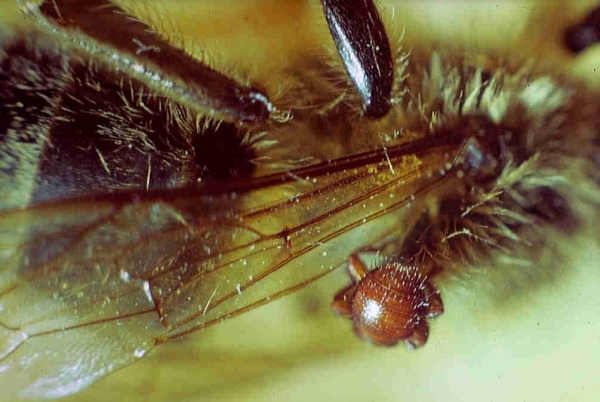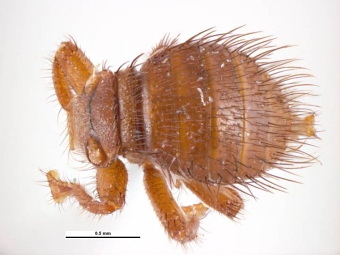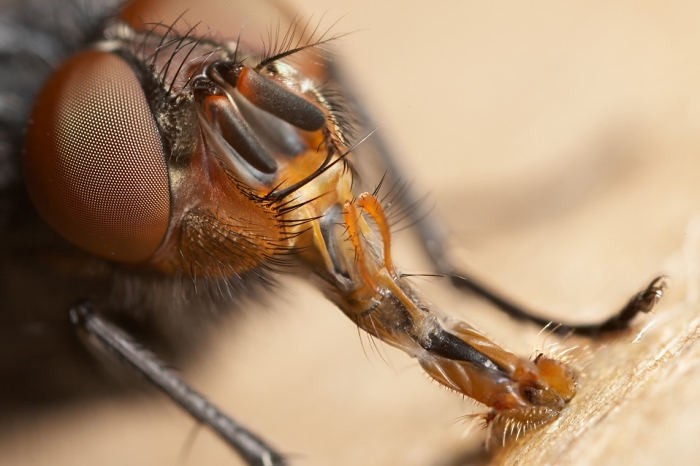| Bogleech Presents The Top Twenty Coolest Flies |
| #14 - Pontomyia - Marine Midges |
Despite representing the majority of life as we know it, insects are technically absent from the majority of the
planet Earth itself, as the only insects known to inhabit seawater are a few Water Striders (true bugs) and the
four known species of Pontomyia, the intertidal midges. Larvae can be found among the rocks and corals of
shallow tide pools, feeding exclusively on certain species of algae or seagrass. The adult female is wingless,
limbless and still very maggotlike in appearance, while the adult male is unlike any other insect. He cannot fly,
but his reduced, paddle-like wings blow him across the water's surface like a hydrofoil, skating on the tips of
only his two middle legs. He will use his other limbs to carry a female and mate on the move, sometimes even
helping strip away her pupal skin. The entire adult life of the male is only a few hours, much shorter than the
famously short-lived mayflies (which are not Diptera), and he lacks a mouth, as he will never have use for
one.
planet Earth itself, as the only insects known to inhabit seawater are a few Water Striders (true bugs) and the
four known species of Pontomyia, the intertidal midges. Larvae can be found among the rocks and corals of
shallow tide pools, feeding exclusively on certain species of algae or seagrass. The adult female is wingless,
limbless and still very maggotlike in appearance, while the adult male is unlike any other insect. He cannot fly,
but his reduced, paddle-like wings blow him across the water's surface like a hydrofoil, skating on the tips of
only his two middle legs. He will use his other limbs to carry a female and mate on the move, sometimes even
helping strip away her pupal skin. The entire adult life of the male is only a few hours, much shorter than the
famously short-lived mayflies (which are not Diptera), and he lacks a mouth, as he will never have use for
one.
| #13 - Ant-mugging flies |
When a hungry ant requires emergency sustenance, she finds one of her sisters and strokes her face with
her feelers in an intimate signal unique to every ant species, triggering the involuntary regurgitation of stored
food. It's a secret ant handshake that says "puke in my mouth!" and Milichia patrizii is just one example of a
non-ant that has cracked the code. Uniquely, it uses its own antennae as a pair of clamps to grab an ant's
feeler, then uses its sponging mouth to tap out the password. Once it slurps the predigested goo from the
ant's jaws, it flies away and leaves the ant in a temporary daze.
her feelers in an intimate signal unique to every ant species, triggering the involuntary regurgitation of stored
food. It's a secret ant handshake that says "puke in my mouth!" and Milichia patrizii is just one example of a
non-ant that has cracked the code. Uniquely, it uses its own antennae as a pair of clamps to grab an ant's
feeler, then uses its sponging mouth to tap out the password. Once it slurps the predigested goo from the
ant's jaws, it flies away and leaves the ant in a temporary daze.
| #12 - Microdon - the slug maggots |
Another tormentor of ants, this fleshy dome is a highly unusual maggot which lurks deep within their
underground colonies, protected by its thick, shield-like back while it eats its daily fill of ant eggs or grubs.
When these little critters were first discovered, their slug-like appearance and movements got them classified
as mollusks, but subsequent specimens were observed metamorphosing into hoverflies. Several different
hoverfly species share this type of larval stage and are currently grouped together as the genus Microdon,
but may in fact represent several groups who stumbled onto the same survival strategy. The orange tube on
this one is the breathing snorkel on its rear end, while the mouth is on its underside.
underground colonies, protected by its thick, shield-like back while it eats its daily fill of ant eggs or grubs.
When these little critters were first discovered, their slug-like appearance and movements got them classified
as mollusks, but subsequent specimens were observed metamorphosing into hoverflies. Several different
hoverfly species share this type of larval stage and are currently grouped together as the genus Microdon,
but may in fact represent several groups who stumbled onto the same survival strategy. The orange tube on
this one is the breathing snorkel on its rear end, while the mouth is on its underside.
| Written by Jonathan Wojcik |
| Robber Fly Photographed by Thomas Shahan |
Some of them eat feces, some of them suck blood, and some of them are responsible for spreading the
deadliest diseases known to man. They're the gnats, mosquitoes and "true" flies, insects of the order Diptera
or "two winged" insects, and have caused more trouble for Homo sapiens than perhaps any other order in
the animal kingdom. Of course, with over 120,000 described species and more than twice as many estimated
to exist, the flies are an extremely varied bunch, adapted to every environment where insects thrive and
some where they normally don't.
deadliest diseases known to man. They're the gnats, mosquitoes and "true" flies, insects of the order Diptera
or "two winged" insects, and have caused more trouble for Homo sapiens than perhaps any other order in
the animal kingdom. Of course, with over 120,000 described species and more than twice as many estimated
to exist, the flies are an extremely varied bunch, adapted to every environment where insects thrive and
some where they normally don't.
| #11 - Braula - the Bee Louse |
Imagine dealing with a literal monkey on your back. A tiny, hairy little gremlin whose barbed claws hold tight
no matter how you shake, twist or pull. Worst of all, whenever the little bastard gets hungry, he climbs down
your face and forces you to vomit, lapping up a few drops of your last meal as it congeals on your shirt. Such
is the suffering of a honeybee at the tiny hands of the "bee louse," Braula coeca. Taking things much farther
than the ant-mugging fly, this wingless parasite lives directly on its bee host and simply clambers to the
mouth when it wants a snack of upchuck. The tiny pest allows most of the sweet, sticky treasure to go to
waste, and multiple "lice" may shorten the bee's lifespan like some sort of living, crawling bulimia.
Or beelimia. You're welcome.
no matter how you shake, twist or pull. Worst of all, whenever the little bastard gets hungry, he climbs down
your face and forces you to vomit, lapping up a few drops of your last meal as it congeals on your shirt. Such
is the suffering of a honeybee at the tiny hands of the "bee louse," Braula coeca. Taking things much farther
than the ant-mugging fly, this wingless parasite lives directly on its bee host and simply clambers to the
mouth when it wants a snack of upchuck. The tiny pest allows most of the sweet, sticky treasure to go to
waste, and multiple "lice" may shorten the bee's lifespan like some sort of living, crawling bulimia.
Or beelimia. You're welcome.
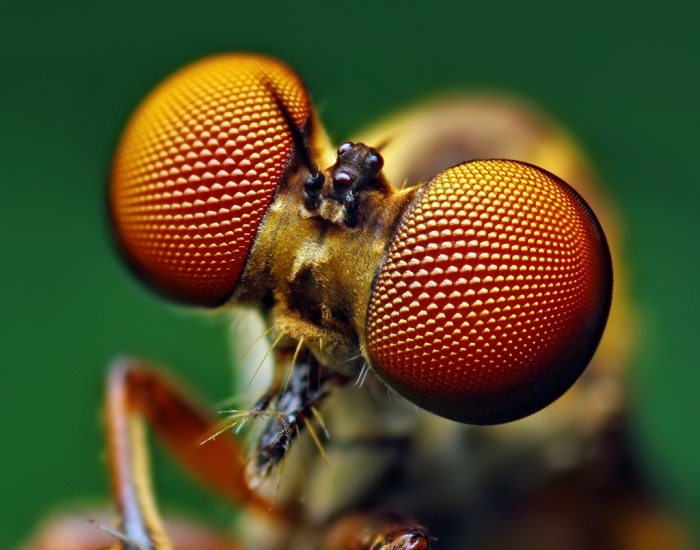
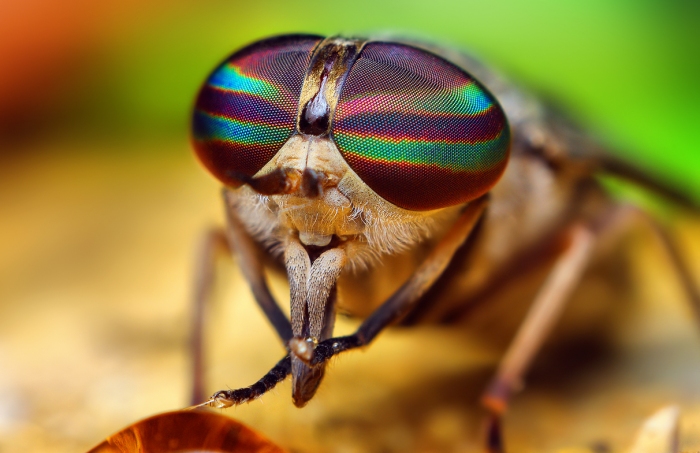
While you're much more likely to encounter the pesky ones (probably why they're considered pesky to begin
with), the majority of flies have no interest in our bodies or our homes and include key pollinators for
thousands of plant species, such as the precious, precious cocoa tree and over 100 other cultivated crops.
Predatory and parasitic flies are integral to the regulation of other insect populations, and even the hated
trash-eating flies provide a valuable service by - fancy that - eating trash. In fact, flies are the terrestrial
world's most widespread and most effective janitorial crew, quickly gobbling up the majority of carrion and
other decaying organic matter before it can become a natural biohazard.
with), the majority of flies have no interest in our bodies or our homes and include key pollinators for
thousands of plant species, such as the precious, precious cocoa tree and over 100 other cultivated crops.
Predatory and parasitic flies are integral to the regulation of other insect populations, and even the hated
trash-eating flies provide a valuable service by - fancy that - eating trash. In fact, flies are the terrestrial
world's most widespread and most effective janitorial crew, quickly gobbling up the majority of carrion and
other decaying organic matter before it can become a natural biohazard.
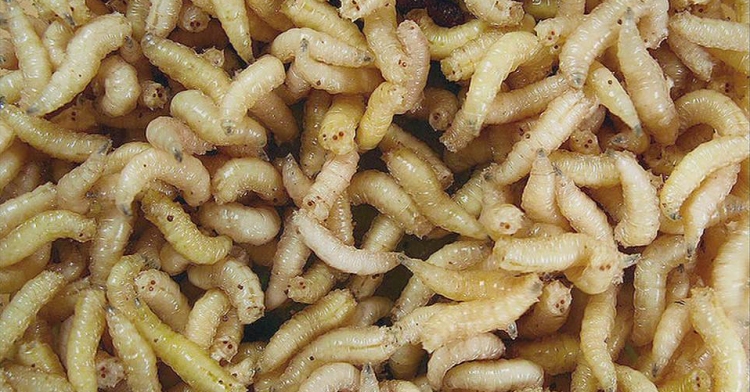
All true flies undergo a complete metamorphosis, most species beginning their existence as the larvae we call
maggots. Everybody loves to harp on these little guys as one of the "grossest" animals in nature, but it's
hardly their fault that they're so small, numerous and squirmy. They need to be, or they wouldn't do their jobs
so well. Nothing cleans up a rotting carcass as quickly and thoroughly as a million little mouths on minimalist,
conical bodies, using their tusk-like hooks and digestive salivary secretion to strip the last scrap of meat from
the last glistening bone. It's Mother Nature's patented stain-lifting formula - it can even get those stubborn
squirrel smears out of asphalt.
maggots. Everybody loves to harp on these little guys as one of the "grossest" animals in nature, but it's
hardly their fault that they're so small, numerous and squirmy. They need to be, or they wouldn't do their jobs
so well. Nothing cleans up a rotting carcass as quickly and thoroughly as a million little mouths on minimalist,
conical bodies, using their tusk-like hooks and digestive salivary secretion to strip the last scrap of meat from
the last glistening bone. It's Mother Nature's patented stain-lifting formula - it can even get those stubborn
squirrel smears out of asphalt.
| Horsefly Photographed by Thomas Shahan |
Adult flies are distinguished from nearly all other flying insects by having only their front wings adapted for
flight, the rear wings having been reduced to knob-like organs called "halteres," which actually function as
gyroscopes to maintain the insect's aerial balance. The mouth parts of a fly can only take in liquids, but are
adapted to a broad variety of diets; many species famously regurgitate digestive enzymes to liquefy solid
foods externally, soaking up the mush into a sponge-like pad. Parasites like horseflies use a set of serrated
blades to saw through flesh and lap up blood, while mosquitoes employ a delicate drilling and siphoning
system. With their often very brief adult stages, however, not all flies have time to eat or even have mouths,
and for that matter, not all flies can even fly. The Diptera have taken forms even stranger than the most
divergent beetles, and by the time we're done, you're going to either love them or hate them like you never
have before. Preferably the former.
flight, the rear wings having been reduced to knob-like organs called "halteres," which actually function as
gyroscopes to maintain the insect's aerial balance. The mouth parts of a fly can only take in liquids, but are
adapted to a broad variety of diets; many species famously regurgitate digestive enzymes to liquefy solid
foods externally, soaking up the mush into a sponge-like pad. Parasites like horseflies use a set of serrated
blades to saw through flesh and lap up blood, while mosquitoes employ a delicate drilling and siphoning
system. With their often very brief adult stages, however, not all flies have time to eat or even have mouths,
and for that matter, not all flies can even fly. The Diptera have taken forms even stranger than the most
divergent beetles, and by the time we're done, you're going to either love them or hate them like you never
have before. Preferably the former.
| #15 - Vermileonidae - the Wormlions |
| #18 - "Stick Tick" |
| Housefly shot by Brian V |
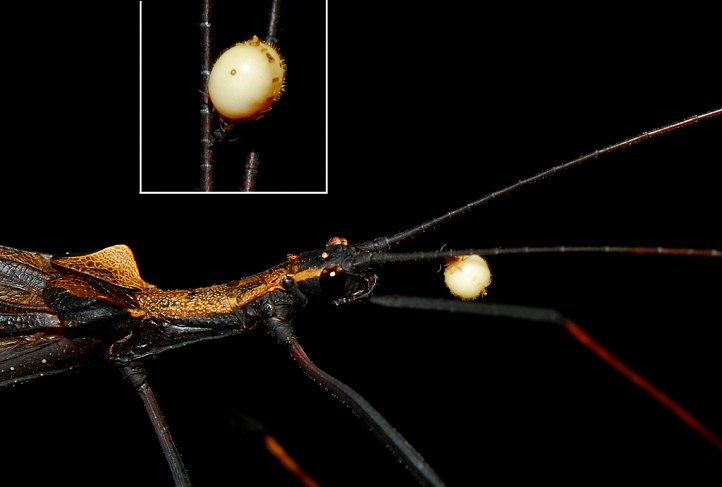
While some insect groups are more commonly or even exclusively parasitic, the flies seem to display a wider
variety of parasitic habits than any other animal Order, and in fact, parasites are going to make up nearly half
of this list. Our first example is a very obscure oddball; this tiny, biting midge attaches itself to the soft joints
of walking sticks (phasmidae) and gorges itself on fluids in a more tick-like than fly-like manner.
variety of parasitic habits than any other animal Order, and in fact, parasites are going to make up nearly half
of this list. Our first example is a very obscure oddball; this tiny, biting midge attaches itself to the soft joints
of walking sticks (phasmidae) and gorges itself on fluids in a more tick-like than fly-like manner.
| Photo by Artour A - more insects on his Flickr! |
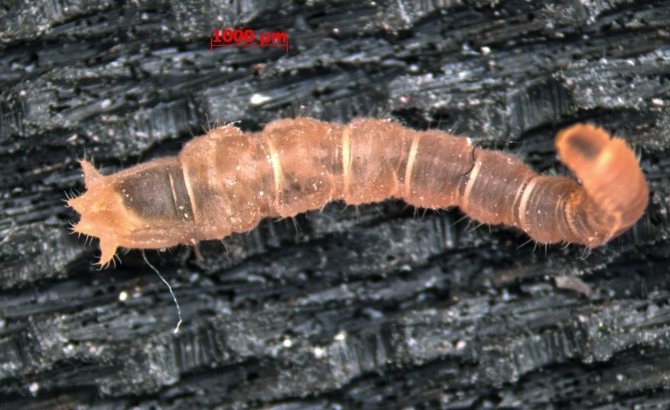
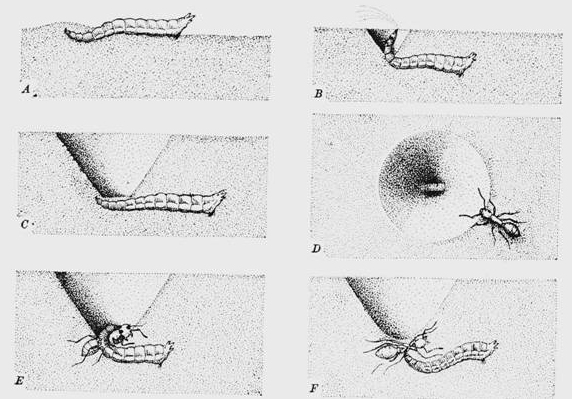
The larval stage of antlions are famous for excavating treacherous pits in loose sand, waiting at the
bottom for unsuspecting insects to tumble into their hungry jaws and even throwing sand to make escape
more difficult. Antlions are not Diptera; their adult stage is four-winged, and belongs to the order Neuroptera.
Wormlions, on the other hand, are true flies whose larval stage has strikingly evolved an identical hunting
strategy, including the sand-hurling attack. The sticky, hairy body of this tiny sarlacc collects a layer of sand
to become almost invisible at the base of the trap, and lacking the long jaws of an antlion, it clamps prey
between its tiny fangs and a small sucker on its barb-covered rump.
bottom for unsuspecting insects to tumble into their hungry jaws and even throwing sand to make escape
more difficult. Antlions are not Diptera; their adult stage is four-winged, and belongs to the order Neuroptera.
Wormlions, on the other hand, are true flies whose larval stage has strikingly evolved an identical hunting
strategy, including the sand-hurling attack. The sticky, hairy body of this tiny sarlacc collects a layer of sand
to become almost invisible at the base of the trap, and lacking the long jaws of an antlion, it clamps prey
between its tiny fangs and a small sucker on its barb-covered rump.
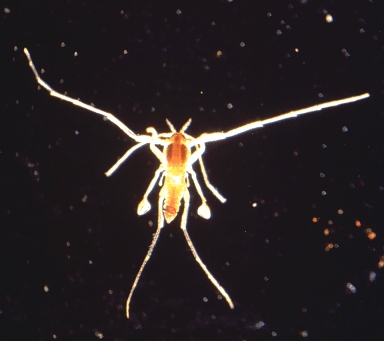
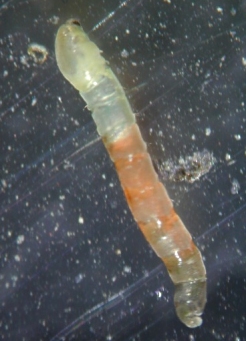
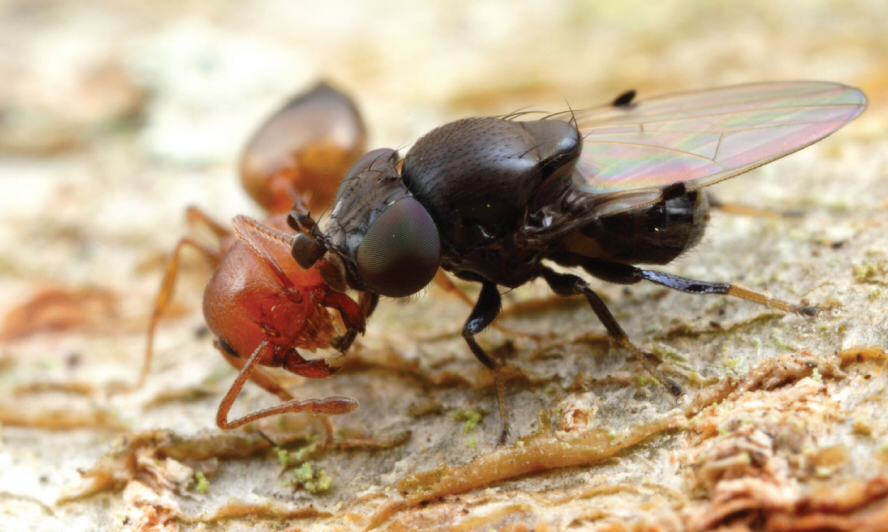
| Photo by Alex Wild |
| #19 - Chionea - the Snow Flies |
The first of many wingless flies (walks?) on our list, Chionea are part of the crane fly family, and among the
world's few insects at home in the ice and snow. In fact, Chionea flock to the coldest spots they can find, and
can survive at some of the highest altitudes of any macroscopic animal thanks to the natural antifreeze
(glycerol) present in their hemolymph (insect blood). Use of wings would not only get them blown away in
powerful winds, but quickly expend energy and heat in fatal amounts. Adults may drink water by pressing
their faces into snow but are not known to eat, while larvae feed on dead vegetation, moss, lichen and animal
droppings.
world's few insects at home in the ice and snow. In fact, Chionea flock to the coldest spots they can find, and
can survive at some of the highest altitudes of any macroscopic animal thanks to the natural antifreeze
(glycerol) present in their hemolymph (insect blood). Use of wings would not only get them blown away in
powerful winds, but quickly expend energy and heat in fatal amounts. Adults may drink water by pressing
their faces into snow but are not known to eat, while larvae feed on dead vegetation, moss, lichen and animal
droppings.
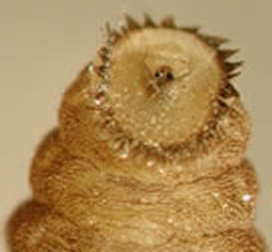
| #20 - the vampire maggots |
Everybody knows about blood-sucking flies, but blood-sucking (hematophagous) maggots are surprisingly
obscure. Larvae of a single blowfly genus, Auchmeromyia, share the same feeding habits as bedbugs, hiding
in the bedding and nesting materials of mammals during the day and emerging at night to drink blood from
sleeping hosts. Auchmeromyia senegalensis, commonly called the "congo floor maggot" (more photos here)
prefers the blood of us humans, but unlike bedbugs, they are completely unequipped for climbing. A bed
held off the ground by an ordinary frame will stop the little ghouls in their tracks, and has significantly
reduced their prevalence in human homes.
obscure. Larvae of a single blowfly genus, Auchmeromyia, share the same feeding habits as bedbugs, hiding
in the bedding and nesting materials of mammals during the day and emerging at night to drink blood from
sleeping hosts. Auchmeromyia senegalensis, commonly called the "congo floor maggot" (more photos here)
prefers the blood of us humans, but unlike bedbugs, they are completely unequipped for climbing. A bed
held off the ground by an ordinary frame will stop the little ghouls in their tracks, and has significantly
reduced their prevalence in human homes.
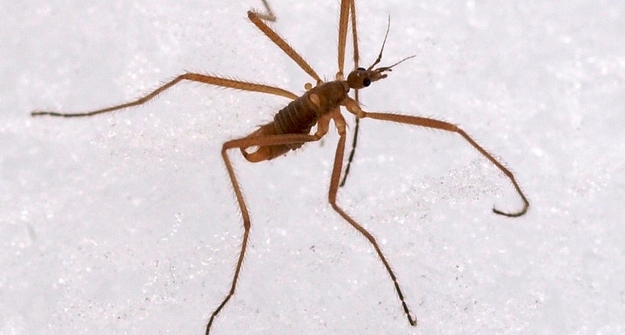
| #16 - Chaoboridae - the phantom midges |
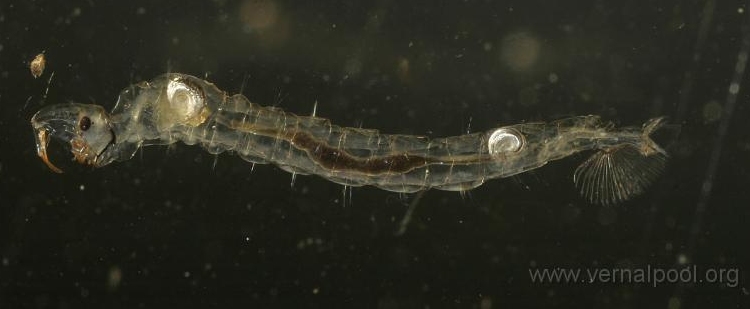
| Visit Vernalpool.org for information on vernal pools and a massive gallery of beautiful images! |
As adults, the phantom midges resemble tiny, feather-faced mosquitoes and may feed on only nectar or
never feed at all, living only long enough to mate and die. Like several entries on our list, it's the larval stage
that makes Chaoboridae stand out; a fully aquatic predator propelled by delicate "fins" on its tail. Unlike any
other known insect, the antennae of this transparent killer are modified into mantis-like claws, used to impale
such prey as fairy shrimp or mosquito larvae.
never feed at all, living only long enough to mate and die. Like several entries on our list, it's the larval stage
that makes Chaoboridae stand out; a fully aquatic predator propelled by delicate "fins" on its tail. Unlike any
other known insect, the antennae of this transparent killer are modified into mantis-like claws, used to impale
such prey as fairy shrimp or mosquito larvae.
| #17 - the Crab Flies |
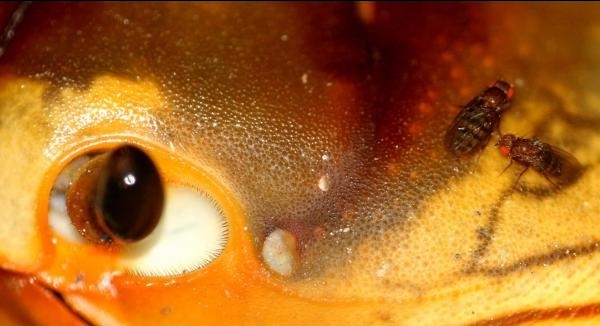
| Max Planck Institute for Chemical Ecology/Stensmyr |
A great example of the ultra-specific environments some insects can adapt to, Drosophila endobranchia is a
species of "fruit" fly that seems to breed exclusively in the mouths of land crabs. The maggots are not
harmful parasites, but feed on bacteria and mucus until they crawl onto the crab's face and metamorphose
into adults. Males seem to fly poorly and rarely even attempt to do so, staking out a prime standing spot on
the crab's face and defending it from rivals. Females, seen less often, are thought to take wing after mating
and find new crabs to colonize.
species of "fruit" fly that seems to breed exclusively in the mouths of land crabs. The maggots are not
harmful parasites, but feed on bacteria and mucus until they crawl onto the crab's face and metamorphose
into adults. Males seem to fly poorly and rarely even attempt to do so, staking out a prime standing spot on
the crab's face and defending it from rivals. Females, seen less often, are thought to take wing after mating
and find new crabs to colonize.
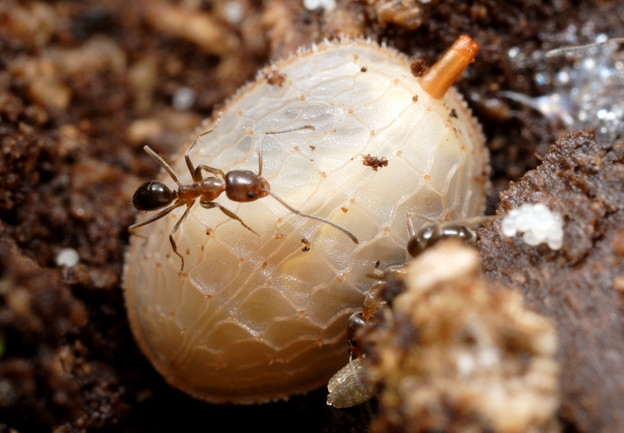
| Photo by Alex Wild |
